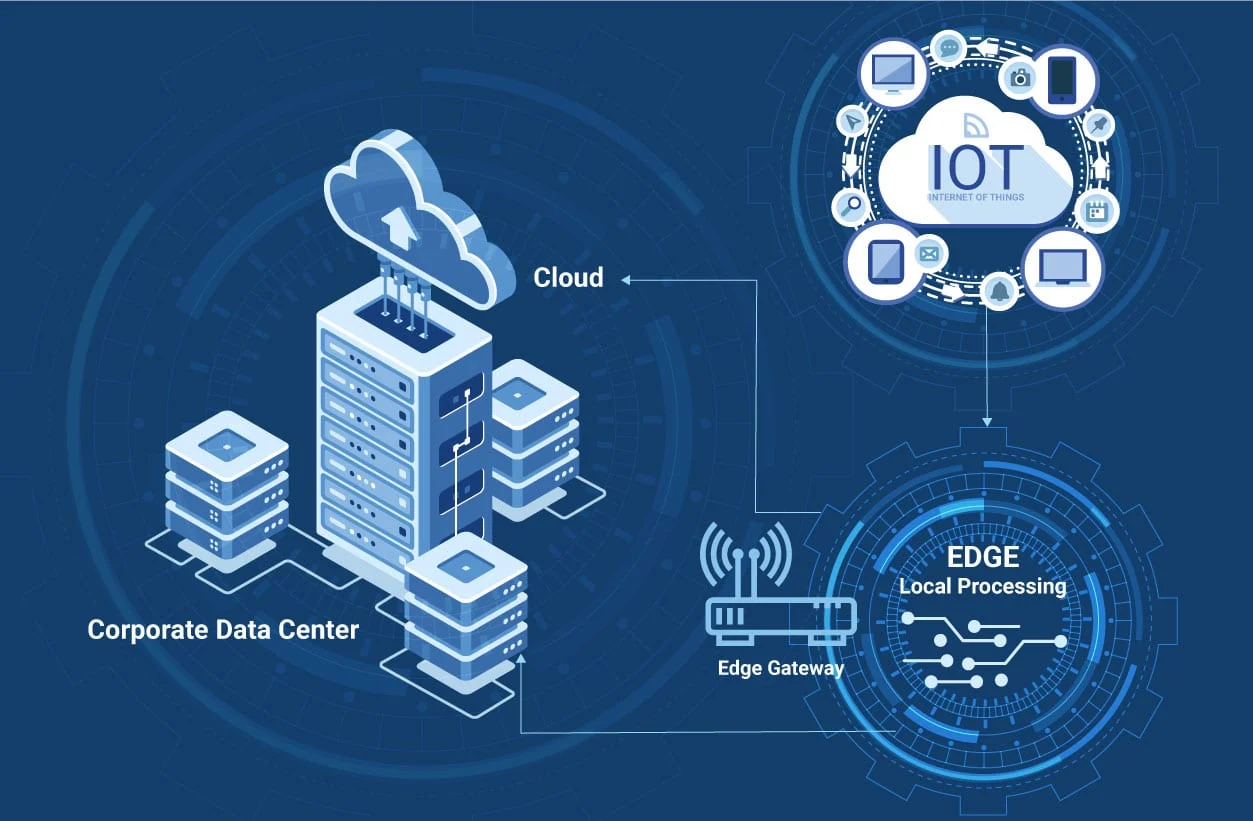The Impact of Edge Computing on IoT Development is a significant topic in the realm of technology. Edge computing has revolutionized the way IoT devices process and analyze data, allowing for faster response times and reduced latency. This has led to improved efficiency and real-time decision making in various industries such as manufacturing, healthcare, and smart cities. Additionally, edge computing has enabled IoT devices to operate with limited connectivity and reduced dependence on cloud infrastructure, leading to cost savings and improved reliability.
Edge computing’s influence on the advancement of IoT development has sparked a great deal of curiosity and interest. Many are eager to understand how edge computing can enhance the security of IoT devices and protect sensitive data. Furthermore, there is a growing interest in the potential impact of edge computing on the scalability and interoperability of IoT systems. Additionally, the ways in which edge computing can optimize energy usage and resource allocation in IoT devices is a topic of increasing interest. Overall, the impact of edge computing on IoT development is a multifaceted and dynamic area of exploration.
The Evolution of IoT with Edge Computing
Edge computing has revolutionized the way IoT devices process and analyze data. Traditionally, IoT devices would send all the data they collect to a central cloud server for processing. However, with edge computing, these devices can now process and analyze data locally, at the edge of the network, before sending relevant information to the cloud. This not only reduces latency and bandwidth usage but also enables real-time decision-making and response.
Furthermore, edge computing allows IoT devices to operate efficiently in environments with limited or intermittent connectivity to the central cloud. This has expanded the capabilities of IoT applications, enabling them to be deployed in a wider range of industries and use cases, from smart cities and healthcare to manufacturing and agriculture.
Enhanced Security and Privacy in IoT Applications
Edge computing has also brought about improvements in security and privacy for IoT applications. By processing and analyzing data locally, sensitive information can be kept within the confines of the edge network, reducing the risk of exposure to potential security threats. Additionally, edge computing enables data to be anonymized and aggregated at the edge, minimizing the transmission of personally identifiable information to the central cloud.
With the implementation of edge computing, IoT developers can ensure that data remains secure and private throughout the entire data lifecycle, from collection and processing to storage and transmission. This has become increasingly important as IoT applications continue to proliferate across various industries and domains.
Reduced Network Congestion and Bandwidth Usage
One of the key advantages of edge computing in IoT development is the reduction in network congestion and bandwidth usage. By processing and filtering data at the edge of the network, only relevant information is transmitted to the central cloud, reducing the volume of data traveling through the network. This not only alleviates network congestion but also minimizes the strain on bandwidth, resulting in more efficient and cost-effective data transmission.
Furthermore, by offloading processing tasks to edge devices, the overall network performance is enhanced, leading to improved scalability and reliability of IoT applications. As the number of connected devices continues to grow, the implementation of edge computing becomes crucial in ensuring the seamless operation of IoT ecosystems.
Real-time Decision Making and Response
Edge computing empowers IoT devices to make real-time decisions and responses, without having to rely solely on the central cloud for instructions. By processing and analyzing data locally, edge devices can respond to critical events and triggers instantaneously, leading to faster reaction times and improved operational efficiency. This capability is particularly beneficial in applications such as autonomous vehicles, industrial automation, and healthcare monitoring.
Moreover, real-time decision-making at the edge enables IoT applications to continue functioning even in cases of intermittent or disrupted connectivity to the central cloud. This resilience is essential in mission-critical scenarios where immediate action is required, showcasing the significant impact of edge computing on the evolution of IoT development.
Efficient Utilization of Resources and Energy
Edge computing plays a crucial role in optimizing the utilization of resources and energy in IoT deployments. By processing and analyzing data locally, edge devices can reduce the amount of data that needs to be transmitted to the central cloud, leading to lower energy consumption and extended battery life for battery-operated IoT devices. This is particularly important in applications such as wearable devices and remote sensors.
Furthermore, edge computing enables the offloading of computational tasks from the central cloud to edge devices, distributing the processing load and improving the overall efficiency of the IoT ecosystem. This results in a more sustainable and environmentally friendly approach to IoT development, aligning with the global efforts towards energy conservation and sustainability.
Challenges and Considerations in Implementing Edge Computing for IoT
While the benefits of edge computing in IoT development are substantial, there are also challenges and considerations that need to be addressed. One of the primary challenges is the management and orchestration of edge resources, including devices, applications, and data. Ensuring the seamless integration and coordination of edge components is crucial for the effective operation of IoT systems.
Additionally, security and privacy concerns persist in edge computing, as the distributed nature of edge devices introduces new attack vectors and vulnerabilities. IoT developers must implement robust security measures and protocols to safeguard edge networks and devices from potential threats and breaches.
Opportunities for Innovation and Differentiation in IoT Solutions
Edge computing presents new opportunities for innovation and differentiation in IoT solutions. By leveraging the capabilities of edge devices, IoT developers can create novel applications and services that deliver enhanced performance, reliability, and user experiences. This opens up avenues for differentiation in competitive markets and drives the evolution of IoT towards more advanced and sophisticated deployments.
Furthermore, the integration of edge computing with emerging technologies such as artificial intelligence and machine learning enables IoT solutions to offer intelligent and autonomous capabilities at the edge. This paves the way for transformative advancements in various industries, shaping the future of IoT development and deployment.
Impact on Industry Verticals and Use Cases
The impact of edge computing on IoT development extends across a wide range of industry verticals and use cases. In sectors such as healthcare, edge computing enables real-time patient monitoring and diagnostics, leading to improved healthcare outcomes and patient care. Similarly, in smart cities, edge-enabled IoT applications facilitate efficient resource management, traffic optimization, and public safety enhancements.
Moreover, in industrial IoT (IIoT) deployments, edge computing plays a pivotal role in enabling predictive maintenance, process optimization, and automation in manufacturing and production environments. The potential of edge computing to revolutionize industry verticals and drive innovation in diverse use cases underscores its significance in shaping the future of IoT.
Standardization and Interoperability in Edge-enabled IoT Ecosystems
As edge computing becomes increasingly integral to IoT development, the need for standardization and interoperability within edge-enabled ecosystems becomes paramount. Standardized protocols and interfaces are essential to ensure seamless communication and integration between diverse edge devices and systems, fostering a cohesive and interoperable IoT landscape.
Additionally, industry-wide collaboration and initiatives are essential to drive the development of standardized frameworks and guidelines for edge computing in IoT. This collaborative effort will not only facilitate the widespread adoption of edge-enabled IoT solutions but also streamline the implementation and management of interconnected edge devices and applications.
Future Trends and Possibilities in Edge-enabled IoT
The future of edge-enabled IoT holds exciting possibilities and trends that are poised to reshape the IoT landscape. As edge computing capabilities continue to advance, we can expect to see the proliferation of edge AI and machine learning at the edge, enabling autonomous decision-making and intelligent processing in IoT applications. This will drive a new wave of innovation and sophistication in edge-enabled IoT solutions.
Furthermore, the integration of 5G networks with edge computing is set to unlock unprecedented levels of speed and connectivity, paving the way for ultra-low latency and high-throughput IoT applications. This convergence of 5G and edge computing will fuel the development of immersive experiences, real-time analytics, and mission-critical IoT deployments, heralding a new era of connectivity and possibilities in the IoT domain.
| Impact | Description |
|---|---|
| Reduced Latency | Edge computing allows IoT devices to process data closer to the source, reducing the time it takes for data to travel to the cloud and back. |
| Bandwidth Savings | By processing data at the edge, only relevant information is sent to the cloud, saving bandwidth and reducing costs. |
| Improved Security | Data processing at the edge can enhance security by reducing the amount of sensitive information sent over the network. |
| Scalability | Edge computing allows for the distribution of computing resources, enabling scalability for IoT deployments. |
| Real-time Insights | Processing data at the edge enables real-time analytics, providing immediate insights for decision-making. |
The impact of edge computing on IoT development is significant, as it enables reduced latency, bandwidth savings, improved security, scalability, and real-time insights. By processing data closer to the source, edge computing enhances the capabilities of IoT devices and opens up new opportunities for innovation in various industries.



